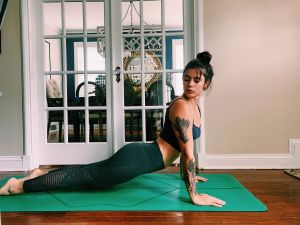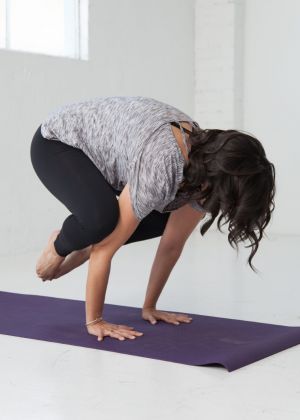With more and more people living in a virtual world, we are all spending far too much time hunched over our computers. In the new world of remote work and zoom meetings, our bodies and in particular, our postures suffer. Stooped shoulders, tight pecs, weak back muscles and out of shape cores all contribute to back issues and poor posture. When we sit for too long, bent over a laptop, desktop or several our hamstrings get tight, our hip flexors remain rigid and our lower back suffers.
Without opening moves to create space in our shoulders and pectoral muscles, our upper back and neck get out of alignment. All resulting in discomfort and stiffness. As we get older, we naturally get more lordotic (hunched over) this impacts not only our physical bodies, but also our mental state and our breathing function. Lower back pain is probably the most common back pain, and a big contributor is stress. Stress and anxiety create stored tension in the body resulting in weakness, exhaustion, illness or chronic pain.
Maintaining good posture and regular exercise can help to greatly reduce lower back problems. For many people, muscle imbalance is the cumulative effect of poor body awareness and bad posture. People also tend to push their bodies too far, overstraining and overreaching, or they don’t push enough, never getting enough exercise and spending too much time in the same sedentary positions.
More than 80% of the population will experience significant back pain and poor posture at some point during their life. Many people end up having only a few episodes of back pain while others will have it progress to a chronic condition. Back pain affects men and women equally. It can occur at any age, but most frequently between ages 25 and 60.
Fortunately, we have yoga, the perfect solution to good posture, better breathing and a relaxed mind. Yoga is a useful tool for dealing with back problems. It teaches us to breathe more deeply, to consciously connect with our body and deepen our awareness. Yoga helps us release physical and mental tension. More and more people are turning to Yoga as a compliment to a life of sitting. Yoga increases flexibility, enhances core body strength, focuses the mind, increases breath awareness and vitality, and relieves stress.
The study of yoga is based on 5,000 years of observances and theories involving the mind-body connection. A regular yoga practice deepens our mind-body connection which enables us to heal both emotionally and physically as we create a state of well-being. Maintaining a regular yoga practice over time helps create energy flow as well as bring balance to the circulatory, respiratory, nervous, digestive, reproductive and excretory system. Modern science and medicine are proving that making this mind-body connection is essential to effectively healing and balancing all the systems of the body as well as the mind. Yoga’s primary intention is to quiet the mind and restore the body.
Here 7 ways Yoga Improves our posture:
1. Body Awareness – When we practice yoga, we become more aware of our bodies and the signals they send. We can then course correct quickly and sit up straight.
Practice –
Corpse Pose Lying on the back, legs straight, feet 2-3¹ apart, hands down
by the hips, palms face up. Close the eyes, breathing softly, and completely
relax the body and the mind. Hold for 5-10 minutes – check in with your body and you relax and breathe
2. Strengthens your core – Everything you do in life needs your core muscles, and almost everything in yoga works on your core strength. When we have a weak core, our spines and torso are not as supported, our lower back suffers and we get a rounded spine (think of a hunch back) Strong and stabilized core muscles in turn help with overall life performance
Practice Sit ups every day and Boat Pose.
3. Keeps our bones and muscles strong –
Working against our own body weight in yoga makes our muscles and bones strong, supporting good posture.
Practice – Downward-facing Dog Beginning in extended Child¹s Pose, sitting on the
heels, forehead to the floor. Hands are shoulder width apart, arms fully
extended in front of you. Come forward onto the knees, curl the toes and
lift the hips towards the ceiling pressing the palms into the floor, pushing
the hips up and back towards the wall behind you. Straighten the torso in
line with the arms and shoulders and try to straighten the legs, pressing
the heels to the floor. Feet should be hips distance apart; you should look
like an inverted ³V²
4. Opens your pecs – Forward folding gives us tight pectoral (chest) muscles, pulling our shoulders forward and weakening the back muscles. Using our back muscles (our good posture muscles) helps us keep the chest open creating better posture
Practice – Chest Expansion –
5. Improves back Strength – Yoga strengthen all the muscles that surround and support the spine
Practice – Superperson pose. Lying faced down- lift the arms to the sides or out in front of you, lift your legs off the floor. Focus on activating all the muscles in te back of the body.
6. Increases lung function and capacity – When we practice yoga, we utilize our lungs to full capacity as yoga is based is a breathing practice. When we are taking good deep breaths, we sit up taller and feel better as a result. It is almost impossible to do deep breathing when in a poor postural alignment
7.
Practice – Upward-facing Dog As you inhale, rock forward, pointing the toes, coming
on to the tops of the feet. Bring the torso upright by straightening the
arms and pushing the floor away, keeping the hips close to the wrists, the
legs close to the floor. Lift the chin an arch the back. BREATHE
8. Aligns your spine –
Practice – Mountain pose – Stand tall, feet hips distance apart. Press the soles of the
feet into the mat or floor. Pull up the thighs, squeeze the buttocks, pull
the abdomen in and drop the shoulders down the back. Keeping the chin level,
lift the crown of the head. Close your eyes and take 5-10 deep centering
breaths. Try to make each consecutive breath longer than the first.
Remember Special attention should be paid to the breath, breathing through the nose at all times, with long, deep breaths.
Develop a rhythm or tempo based on the length of the inhale and exhale.
Take your time and come to the full extent of the posture as you come to the end of each breath.
It’s never too late to start yoga. As long as you do something, you’ll begin the process of undoing years of damage. Yoga speeds the healing process. Therapeutic yoga practice has an accumulative effect. Improvement may take several weeks or months but you will soon be sitting up straight and feeling great.
Take your practice and teaching to the next level with our 300-Hour Advanced Yoga Teacher Training.
Stay Connected With Us
Monthly inspiration in your inbox




© 2025 YogaFit Training Systems Worldwide, Inc.